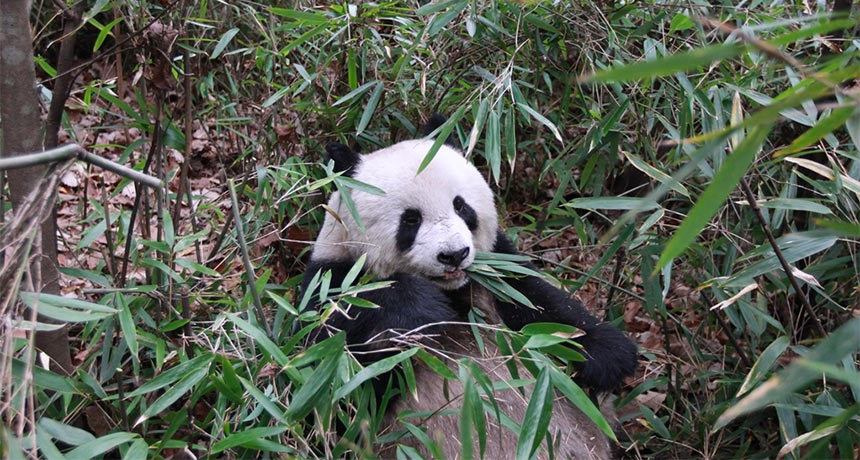Pandas’ share of protein calories from bamboo rivals wolves’ from meat
Skewed digestive powers give the plant eaters the ability to extract the key nutrient

TAKES GUTS A wild panda in China’s Foping Nature Reserve gets a surprising proportion of calories from protein just by eating bamboo, bamboo and then more bamboo.
F. Wei
Giant pandas eat bamboo like a wolf in vegan clothing.
In the wild, pandas devour massive amounts of bamboo and digest it so efficiently that protein from the plants probably supplies at least half of the animals’ calories, a study finds. That’s about on par with measurements of how many calories from protein make up the carnivorous diets of wolves and feral cats, conservation biologist Fuwen Wei of the Chinese Academy of Sciences in Beijing and colleagues report May 2 in Current Biology.
Giant pandas, which evolved from omnivores and carnivores, still show some strong signs of ancestral meat eating. Biologists knew that a panda’s gut works more like a carnivore’s than an herbivore’s, and has microbial residents similar to a carnivore’s. So Wei and colleagues wanted to see how that carnivore-like gut handled a bamboo diet.
Lurking in bamboo stands in China’s Qingling Mountains, the researchers gathered wild panda poop for analysis. Comparing the nutrients excreted by pandas with nutrients in bamboo plants gave the researchers a sense of how much protein, carbohydrates and fat were being absorbed by the animals.
The fieldwork focused on China’s northernmost population of wild pandas, which dine mainly on two bamboo species found in the Foping Nature Reserve. Pandas are not small animals, yet “they do not make a lot of noise in bamboo,” Wei says. But some of the pandas had been fitted with collars carrying GPS trackers, which helped the researchers find and stay within about 20 meters of the animals to quickly scoop up some of the roughly 120 droppings left by each panda in a day of grazing.
From late August, the pandas spend about eight months gorging on the lowland bamboo species Bashania fargesii. Panda feeding changes as the bamboo, and its protein content, changes with the seasons. When new shoots sprouted, pandas shifted to eating them instead of leaves. Those tender shoots offer about 32 percent protein, versus 19 percent in leaves. Then in the summer, pandas move to higher ground and graze on the daintier Fargesia qinlingensis bamboo shoots, which likewise offer a protein advantage.
Detailed analysis of droppings from two of the tracked pandas revealed that the animals’ guts were extracting proportionally more protein than carbs or fat from the bamboo. The analysis only looked at the share of nutrients, without calculating total amounts.
There’s not a lot of protein in bamboo, Wei notes. “That is why a panda spends lots of time eating the bamboo.”
Evolutionarily speaking, going from being carnivores to vegans seems like an abrupt change for pandas. But the new result suggests that the bears’ shift to a bamboo diet, with its similarities to carnivores’ diets, is “less abrupt than it might otherwise appear,” Wei and colleagues say.
“It’s all really about cheap calories,” says biochemist Carrie Vance of Mississippi State University, who wasn’t involved in the study. If the bears’ carnivore-like guts will do for extracting the energy that the plant eaters need, “there’s no need to evolve out of what might still work.”
Editor’s note: This story was updated May 2, 2019, to clarify the headline. Pandas get about the same proportion of protein calories from bamboo as some carnivores do from meat, but not necessarily the same amount of calories.






